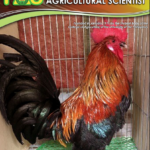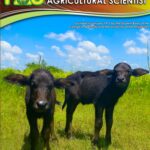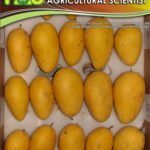Vol. 107, No. 1 (Mar 2024)
Sweet potato tuber infested with sweet potato weevil, Cylas formicarius Fabr. The weevil infests sweet potato plants as early as two weeks after planting but targets the tubers, causing economic losses (Capinera 2021). (https://doi.org/10.62550/RI0310701)
Categories
Articles
Taxonomy of Cassava (Manihot esculenta Crantz) Mealybugs (Hemiptera: Pseudococcidae) - 1: Identification and Local Distribution of the Predominant Species on Witches’ Broom-Diseased Plants in the Philippines
Ireneo L. Lit, Jr., Cristian C. Lucañas, Joanne A. Langres, Lolita M. Dolores, Ruby Ana P. Laude, and Merdelyn T. Caasi-Lit
Received: July 06, 2023 / Revised: October 16, 2023 / Accepted: October 26, 2023
(https://doi.org/10.62550/GZ060023)
Samples of cassava (Manihot esculenta Crantz) plants infected with witches’ broom disease were gathered from 13 provinces in the Philippines. Mealybugs were observed to occur in nine out of the 13 cumulative samples. The most predominant among several mealybug species observed was identified as Pseudococcus jackbeardsleyi Gimpel and Miller. P. jackbeardsleyi is not yet known to transmit phytoplasma, especially the one causing cassava witches’ broom (CWB). However, its occurrence in almost 70% of the CWB-infected samples provides circumstantial evidence that it may be related to the spread of the pathogen. This formal report of identification is in support of the studies on the possible ro...
Samples of cassava (Manihot esculenta Crantz) plants infected with witches’ broom disease were gathered from 13 provinces in the Philippines. Mealybugs were observed to occur in nine out of the 13 cumulative samples. The most predominant among several mealybug species observed was identified as Pseudococcus jackbeardsleyi Gimpel and Miller. P. jackbeardsleyi is not yet known to transmit phytoplasma, especially the one causing cassava witches’ broom (CWB). However, its occurrence in almost 70%...
Feeding Behavior of Sweet Potato Weevil, Cylas formicarius (Fabricius) (Coleoptera: Brentidae) on Three Sweet Potato, Ipomoea batatas L. Cultivars Grown in Tarlac, Philippines
Jerah Mystica B. Novenario and Flor A. Ceballo-Alcantara
Received: October 06, 2022 / Revised: January 05, 2024 / Accepted: January 09, 2024
(https://doi.org/10.62550/JZ100022)
Sweet potato is grown in tropical countries for its edible tubers, which have become an essential food source. It is usually propagated through vine-cutting, which can be obtained from harvested plants or nurseries intended for cutting production only. The recurrent use of vines may cause increased weevil infestation. The crop is known to be infested with insect pests. More importantly, the sweet potato weevil, Cylas formicarius, targets the tubers, thus, causing the economic losses. Sweet potato farmers in Tarlac claim that only one sweet potato cultivar is being attacked by C. formicarius, however, it was found in this experiment that the feeding and feeding behavior of the weevil were ...
Sweet potato is grown in tropical countries for its edible tubers, which have become an essential food source. It is usually propagated through vine-cutting, which can be obtained from harvested plants or nurseries intended for cutting production only. The recurrent use of vines may cause increased weevil infestation. The crop is known to be infested with insect pests. More importantly, the sweet potato weevil, Cylas formicarius, targets the tubers, thus, causing the economic losses. Sweet po...
Agrobacterium-mediated Genetic Transformation and Plant Regeneration from Cotyledons in Philippine Eggplant (Solanum melongena L.) Acc. ‘PH 11424’
Mark Gabriel S. Sagarbarria, John Albert M. Caraan, Patrick G. Lipio, Ian Bien M. Oloc-oloc, Kazuo N. Watanabe, and Desiree M. Hautea
Received: April 28, 2023 / Revised: December 13, 2023 / Accepted: January 16, 2024
(https://doi.org/10.62550/DD042023)
Eggplant (Solanum melongena L.) is one of the most important vegetables grown and consumed in the Philippines hence, continuous breeding programs are vital to maintain the supply of this economically important crop. This study demonstrates the first successful Agrobacterium-mediated genetic transformation and plant regeneration of the Philippine eggplant cultivar ‘PH 11424’, also known as ‘Mistisa’. Cotyledons from 2-wk-old seedlings were used as explants, which were transformed with disarmed Agrobacterium tumefaciens strain LBA4404 harboring a binary vector for CRISPR/Cas9 expression and hygromycin phosphotransferase (HPT), an antibiotic selection marker. Growth of shoot primordia from t...
Eggplant (Solanum melongena L.) is one of the most important vegetables grown and consumed in the Philippines hence, continuous breeding programs are vital to maintain the supply of this economically important crop. This study demonstrates the first successful Agrobacterium-mediated genetic transformation and plant regeneration of the Philippine eggplant cultivar ‘PH 11424’, also known as ‘Mistisa’. Cotyledons from 2-wk-old seedlings were used as explants, which were transformed with disarmed...
Design, Fabrication, and Determination of the Optimum Working Conditions of a Peanut (Arachis hypogaea L.) Pneumatic Bagging System
Selcuk Ugurluay and Ali Somay
Received: November 09, 2022 / Revised: October 02, 2023 / Accepted: October 03, 2023
https://doi.org/10.62550/KW110022
The peanut bagging process is not mechanized, it requires a large amount of human labor. In addition, the shovel or canister used in bagging breaks the peanut shell that causes losses. The purpose of this study is to reduce the required workforce by mechanizing the peanut bagging process, and to determine the optimum working criteria (hose diameter and air velocity) of the prototype machine. A peanut pneumatic bagging machine powered by a tractor power takeoff (PTO) was designed and fabricated to convey peanut pods from the ground and fill the product into the bags. To determine the optimum working conditions of the machine, tests are conducted using three hose diameters (100, 120, and 16...
The peanut bagging process is not mechanized, it requires a large amount of human labor. In addition, the shovel or canister used in bagging breaks the peanut shell that causes losses. The purpose of this study is to reduce the required workforce by mechanizing the peanut bagging process, and to determine the optimum working criteria (hose diameter and air velocity) of the prototype machine. A peanut pneumatic bagging machine powered by a tractor power takeoff (PTO) was designed and fabricate...
Evaluation of the AquaCrop Model for Simulating Cotton Yield Under a Semi-Arid Environment and Different Field Management Practices
Ghorban Ghorbani Nasrabad, Meysam Abedinpour, and Abotaleb Hazarjaribi
Received: May 02, 2022 / Revised: March 27, 2023 / Accepted: March 31, 2023
https://doi.org/10.62550/EDE44022
Cotton plays an important role in increasing productivity in the agricultural sector and related industries in the province of Golestan, Iran. However, the cultivation areas decreased considerably in the last couple of decades due to the high costs of production, water scarcity, and climate change. To encourage sustainable increase in production, crop simulation models are parameterized for each region using observed field data. In this study, the AquaCrop model was calibrated and validated for cotton under different field management scenarios using data from a 3-yr field experiment, which was conducted at the research farm of the National Cotton Research Institute, Golestan, Iran. The fi...
Cotton plays an important role in increasing productivity in the agricultural sector and related industries in the province of Golestan, Iran. However, the cultivation areas decreased considerably in the last couple of decades due to the high costs of production, water scarcity, and climate change. To encourage sustainable increase in production, crop simulation models are parameterized for each region using observed field data. In this study, the AquaCrop model was calibrated and validated f...
Related Post
Mango (Mangifera indica L.) cv. Carabao. This export cultivar, known...


